fuel JEEP WRANGLER 2DOORS 2021 Owner handbook (in English)
[x] Cancel search | Manufacturer: JEEP, Model Year: 2021, Model line: WRANGLER 2DOORS, Model: JEEP WRANGLER 2DOORS 2021Pages: 330, PDF Size: 9.16 MB
Page 7 of 330
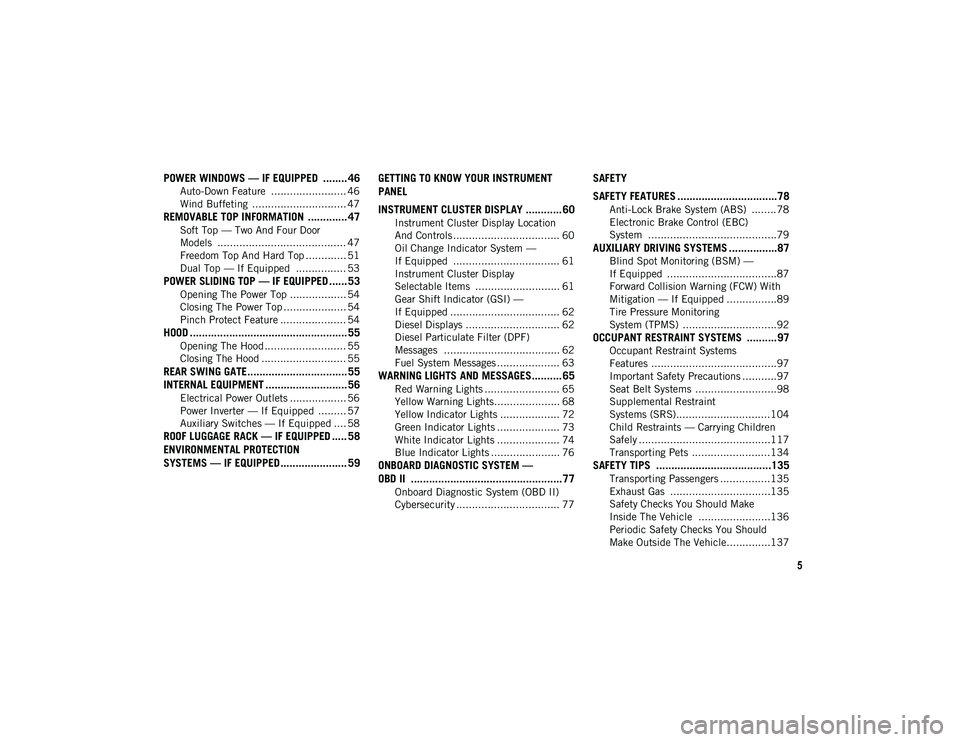
5
POWER WINDOWS — IF EQUIPPED ........ 46
Auto-Down Feature ........................ 46
Wind Buffeting .............................. 47
REMOVABLE TOP INFORMATION ............. 47
Soft Top — Two And Four Door
Models ......................................... 47 Freedom Top And Hard Top ............. 51
Dual Top — If Equipped ................ 53
POWER SLIDING TOP — IF EQUIPPED ...... 53
Opening The Power Top .................. 54
Closing The Power Top .................... 54
Pinch Protect Feature ..................... 54
HOOD .................................................... 55
Opening The Hood .......................... 55
Closing The Hood ........................... 55
REAR SWING GATE................................. 55
INTERNAL EQUIPMENT ........................... 56
Electrical Power Outlets .................. 56
Power Inverter — If Equipped ......... 57
Auxiliary Switches — If Equipped .... 58
ROOF LUGGAGE RACK — IF EQUIPPED ..... 58
ENVIRONMENTAL PROTECTION
SYSTEMS — IF EQUIPPED ...................... 59 GETTING TO KNOW YOUR INSTRUMENT
PANEL
INSTRUMENT CLUSTER DISPLAY ............ 60
Instrument Cluster Display Location
And Controls .................................. 60 Oil Change Indicator System —
If Equipped .................................. 61 Instrument Cluster Display
Selectable Items ........................... 61 Gear Shift Indicator (GSI) —
If Equipped ................................... 62 Diesel Displays .............................. 62
Diesel Particulate Filter (DPF)
Messages ..................................... 62 Fuel System Messages .................... 63
WARNING LIGHTS AND MESSAGES.......... 65
Red Warning Lights ........................ 65
Yellow Warning Lights..................... 68
Yellow Indicator Lights ................... 72
Green Indicator Lights .................... 73
White Indicator Lights .................... 74
Blue Indicator Lights ...................... 76
ONBOARD DIAGNOSTIC SYSTEM —
OBD II ..................................................77
Onboard Diagnostic System (OBD II)
Cybersecurity ................................. 77
SAFETY
SAFETY FEATURES .................................78
Anti-Lock Brake System (ABS) ........78
Electronic Brake Control (EBC)
System .........................................79
AUXILIARY DRIVING SYSTEMS ................87
Blind Spot Monitoring (BSM) —
If Equipped ...................................87 Forward Collision Warning (FCW) With
Mitigation — If Equipped ................89 Tire Pressure Monitoring
System (TPMS) ..............................92
OCCUPANT RESTRAINT SYSTEMS ..........97
Occupant Restraint Systems
Features ........................................97 Important Safety Precautions ...........97
Seat Belt Systems ..........................98
Supplemental Restraint
Systems (SRS)..............................104 Child Restraints — Carrying Children
Safely ..........................................117 Transporting Pets .........................134
SAFETY TIPS ......................................135
Transporting Passengers ................135
Exhaust Gas ................................135
Safety Checks You Should Make
Inside The Vehicle .......................136 Periodic Safety Checks You Should
Make Outside The Vehicle..............137
2020_JEEP_JL_WRANGLER_UG_RHD_UK.book Page 5
Page 8 of 330
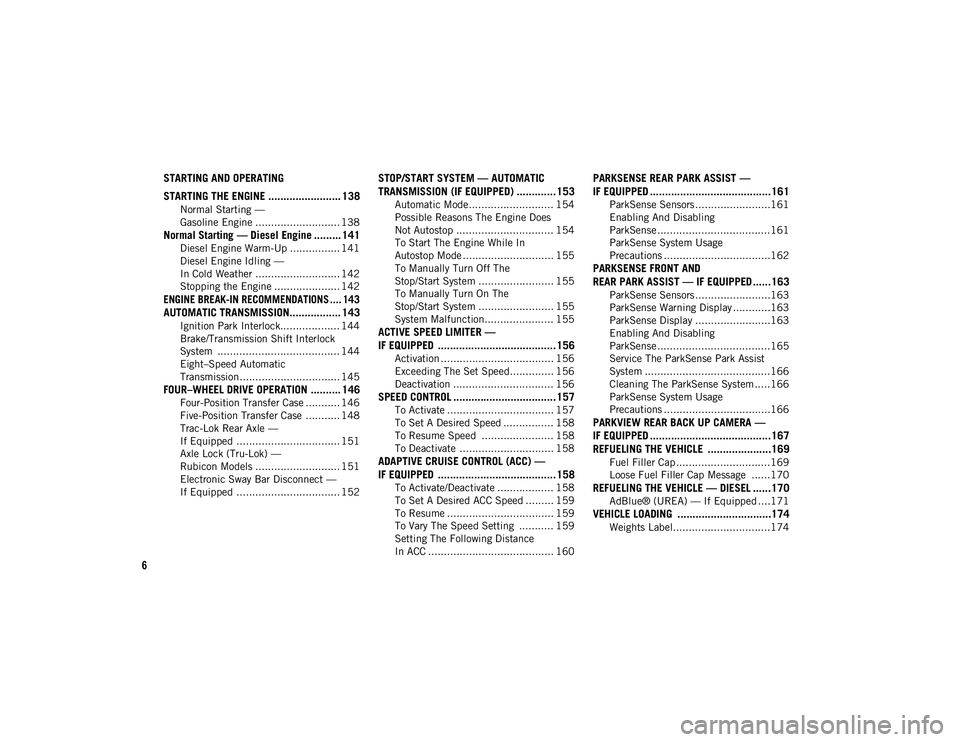
6
STARTING AND OPERATING
STARTING THE ENGINE ........................ 138
Normal Starting —
Gasoline Engine ........................... 138
Normal Starting — Diesel Engine ......... 141
Diesel Engine Warm-Up ................ 141
Diesel Engine Idling —
In Cold Weather ........................... 142 Stopping the Engine ..................... 142
ENGINE BREAK-IN RECOMMENDATIONS .... 143
AUTOMATIC TRANSMISSION................. 143
Ignition Park Interlock................... 144
Brake/Transmission Shift Interlock
System ....................................... 144 Eight–Speed Automatic
Transmission................................ 145
FOUR–WHEEL DRIVE OPERATION .......... 146
Four-Position Transfer Case ........... 146
Five-Position Transfer Case ........... 148
Trac-Lok Rear Axle —
If Equipped ................................. 151 Axle Lock (Tru-Lok) —
Rubicon Models ........................... 151 Electronic Sway Bar Disconnect —
If Equipped ................................. 152
STOP/START SYSTEM — AUTOMATIC
TRANSMISSION (IF EQUIPPED) .............153
Automatic Mode ........................... 154
Possible Reasons The Engine Does
Not Autostop ............................... 154 To Start The Engine While In
Autostop Mode ............................. 155 To Manually Turn Off The
Stop/Start System ........................ 155 To Manually Turn On The
Stop/Start System ........................ 155 System Malfunction...................... 155
ACTIVE SPEED LIMITER —
IF EQUIPPED .......................................156
Activation .................................... 156
Exceeding The Set Speed.............. 156
Deactivation ................................ 156
SPEED CONTROL ..................................157
To Activate .................................. 157
To Set A Desired Speed ................ 158
To Resume Speed ....................... 158
To Deactivate .............................. 158
ADAPTIVE CRUISE CONTROL (ACC) —
IF EQUIPPED .......................................158
To Activate/Deactivate .................. 158
To Set A Desired ACC Speed ......... 159
To Resume .................................. 159
To Vary The Speed Setting ........... 159
Setting The Following Distance
In ACC ........................................ 160
PARKSENSE REAR PARK ASSIST —
IF EQUIPPED ........................................161
ParkSense Sensors ........................161
Enabling And Disabling
ParkSense ....................................161 ParkSense System Usage
Precautions ..................................162
PARKSENSE FRONT AND
REAR PARK ASSIST — IF EQUIPPED ......163
ParkSense Sensors ........................163
ParkSense Warning Display ............163
ParkSense Display ........................163
Enabling And Disabling
ParkSense ....................................165 Service The ParkSense Park Assist
System ........................................166 Cleaning The ParkSense System .....166
ParkSense System Usage
Precautions ..................................166
PARKVIEW REAR BACK UP CAMERA —
IF EQUIPPED ........................................167
REFUELING THE VEHICLE .....................169
Fuel Filler Cap ..............................169
Loose Fuel Filler Cap Message ......170
REFUELING THE VEHICLE — DIESEL ......170
AdBlue® (UREA) — If Equipped ....171
VEHICLE LOADING ...............................174
Weights Label...............................174
2020_JEEP_JL_WRANGLER_UG_RHD_UK.book Page 6
Page 10 of 330
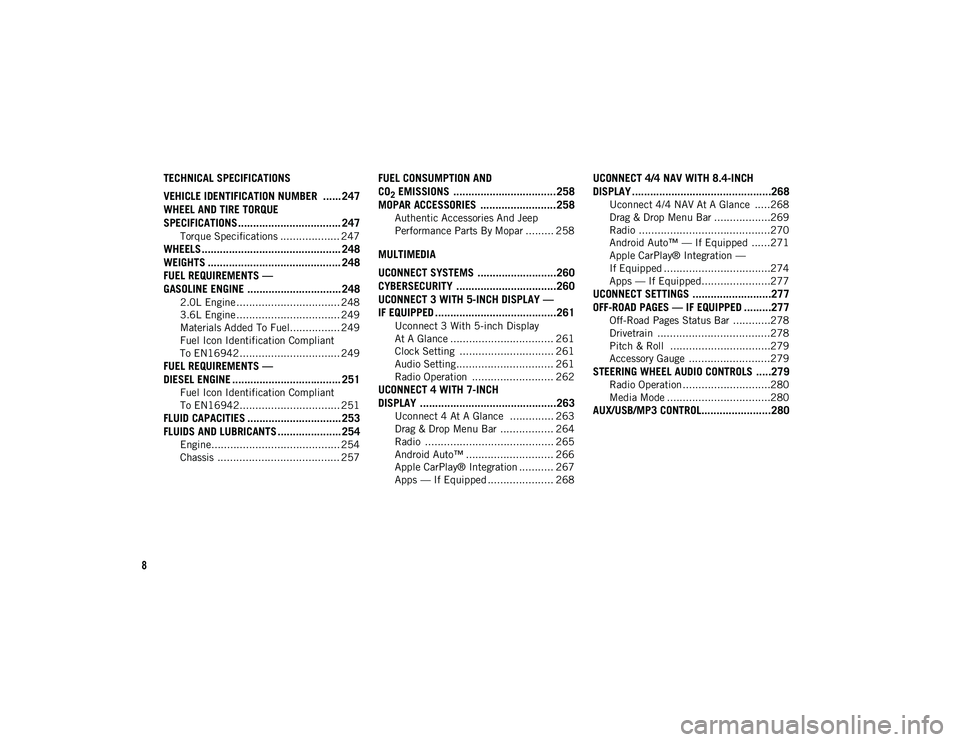
8
TECHNICAL SPECIFICATIONS
VEHICLE IDENTIFICATION NUMBER ...... 247
WHEEL AND TIRE TORQUE
SPECIFICATIONS .................................. 247
Torque Specifications ................... 247
WHEELS .............................................. 248
WEIGHTS ............................................ 248FUEL REQUIREMENTS —
GASOLINE ENGINE ............................... 248
2.0L Engine ................................. 248
3.6L Engine ................................. 249
Materials Added To Fuel................ 249
Fuel Icon Identification Compliant
To EN16942................................ 249
FUEL REQUIREMENTS —
DIESEL ENGINE .................................... 251
Fuel Icon Identification Compliant
To EN16942................................ 251
FLUID CAPACITIES ............................... 253 FLUIDS AND LUBRICANTS ..................... 254
Engine......................................... 254
Chassis ....................................... 257
FUEL CONSUMPTION AND
CO
2 EMISSIONS ..................................258
MOPAR ACCESSORIES .........................258
Authentic Accessories And Jeep
Performance Parts By Mopar ......... 258
MULTIMEDIA
UCONNECT SYSTEMS ..........................260
CYBERSECURITY .................................260
UCONNECT 3 WITH 5-INCH DISPLAY —
IF EQUIPPED ........................................261
Uconnect 3 With 5-inch Display
At A Glance ................................. 261 Clock Setting .............................. 261
Audio Setting............................... 261
Radio Operation .......................... 262
UCONNECT 4 WITH 7-INCH
DISPLAY .............................................263
Uconnect 4 At A Glance .............. 263
Drag & Drop Menu Bar ................. 264
Radio ......................................... 265
Android Auto™ ............................ 266
Apple CarPlay® Integration ........... 267
Apps — If Equipped ..................... 268
UCONNECT 4/4 NAV WITH 8.4-INCH
DISPLAY ..............................................268
Uconnect 4/4 NAV At A Glance .....268
Drag & Drop Menu Bar ..................269
Radio ..........................................270
Android Auto™ — If Equipped ......271
Apple CarPlay® Integration —
If Equipped ..................................274 Apps — If Equipped......................277
UCONNECT SETTINGS ..........................277OFF-ROAD PAGES — IF EQUIPPED .........277
Off-Road Pages Status Bar ............278
Drivetrain ....................................278
Pitch & Roll ................................279
Accessory Gauge ..........................279
STEERING WHEEL AUDIO CONTROLS .....279
Radio Operation ............................280
Media Mode .................................280
AUX/USB/MP3 CONTROL.......................280
2020_JEEP_JL_WRANGLER_UG_RHD_UK.book Page 8
Page 16 of 330
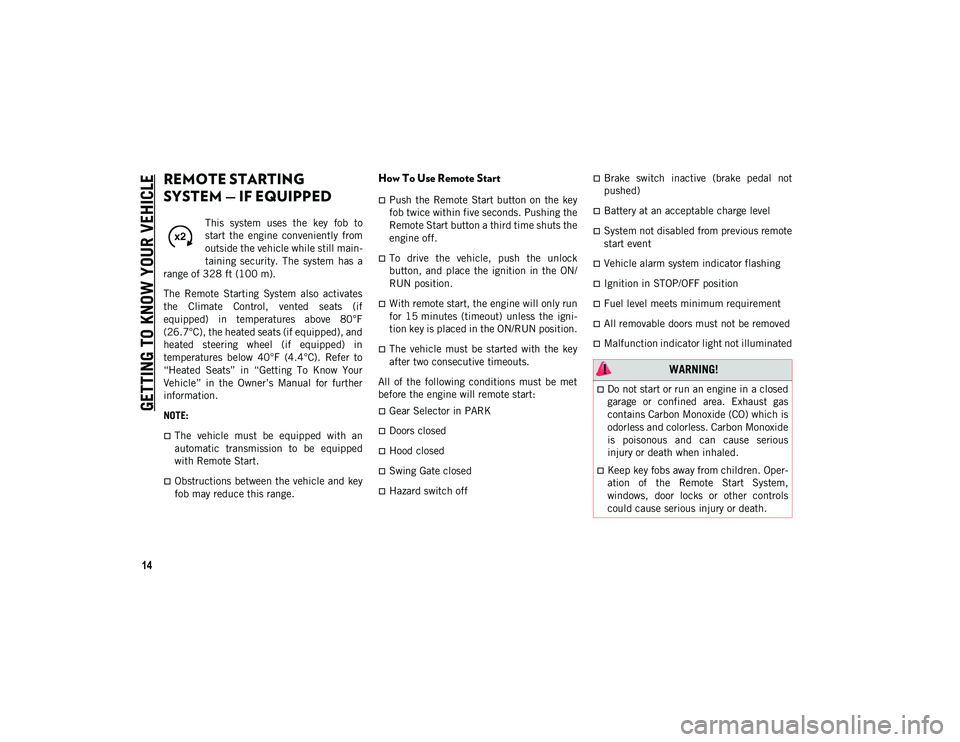
GETTING TO KNOW YOUR VEHICLE
14
REMOTE STARTING
SYSTEM — IF EQUIPPED
This system uses the key fob to
start the engine conveniently from
outside the vehicle while still main-
taining security. The system has a
range of 328 ft (100 m).
The Remote Starting System also activates
the Climate Control, vented seats (if
equipped) in temperatures above 80°F
(26.7°C), the heated seats (if equipped), and
heated steering wheel (if equipped) in
temperatures below 40°F (4.4°C). Refer to
“Heated Seats” in “Getting To Know Your
Vehicle” in the Owner’s Manual for further
information.
NOTE:
The vehicle must be equipped with an
automatic transmission to be equipped
with Remote Start.
Obstructions between the vehicle and key
fob may reduce this range.
How To Use Remote Start
Push the Remote Start button on the key
fob twice within five seconds. Pushing the
Remote Start button a third time shuts the
engine off.
To drive the vehicle, push the unlock
button, and place the ignition in the ON/
RUN position.
With remote start, the engine will only run
for 15 minutes (timeout) unless the igni -
tion key is placed in the ON/RUN position.
The vehicle must be started with the key
after two consecutive timeouts.
All of the following conditions must be met
before the engine will remote start:
Gear Selector in PARK
Doors closed
Hood closed
Swing Gate closed
Hazard switch off
Brake switch inactive (brake pedal not
pushed)
Battery at an acceptable charge level
System not disabled from previous remote
start event
Vehicle alarm system indicator flashing
Ignition in STOP/OFF position
Fuel level meets minimum requirement
All removable doors must not be removed
Malfunction indicator light not illuminated
WARNING!
Do not start or run an engine in a closed
garage or confined area. Exhaust gas
contains Carbon Monoxide (CO) which is
odorless and colorless. Carbon Monoxide
is poisonous and can cause serious
injury or death when inhaled.
Keep key fobs away from children. Oper -
ation of the Remote Start System,
windows, door locks or other controls
could cause serious injury or death.
2020_JEEP_JL_WRANGLER_UG_RHD_UK.book Page 14
Page 17 of 330
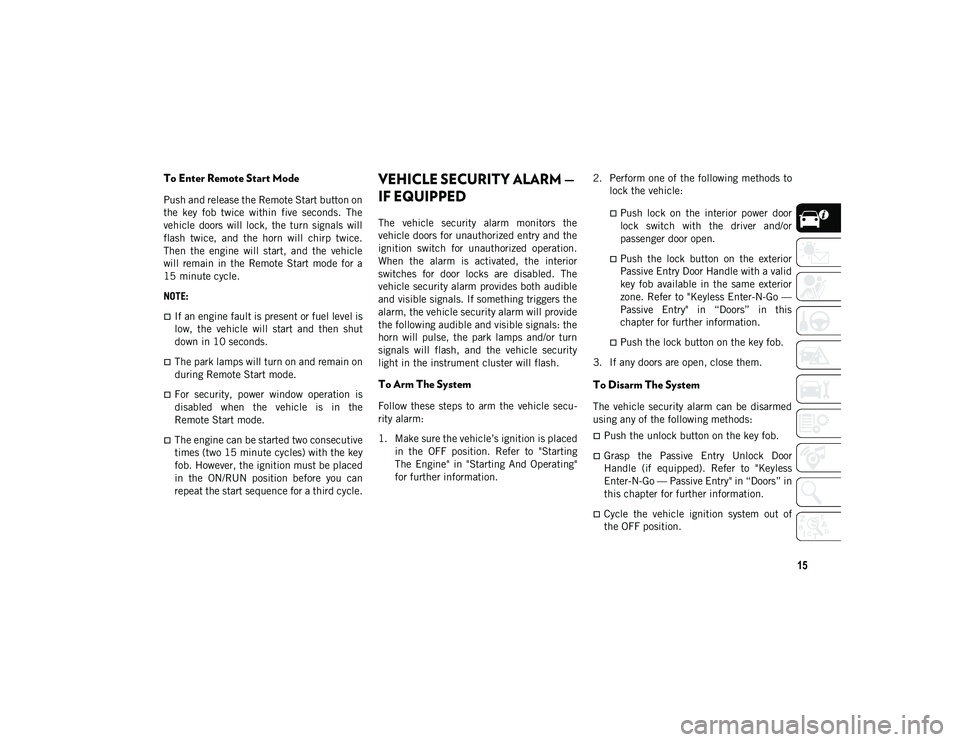
15
To Enter Remote Start Mode
Push and release the Remote Start button on
the key fob twice within five seconds. The
vehicle doors will lock, the turn signals will
flash twice, and the horn will chirp twice.
Then the engine will start, and the vehicle
will remain in the Remote Start mode for a
15 minute cycle.
NOTE:
If an engine fault is present or fuel level is
low, the vehicle will start and then shut
down in 10 seconds.
The park lamps will turn on and remain on
during Remote Start mode.
For security, power window operation is
disabled when the vehicle is in the
Remote Start mode.
The engine can be started two consecutive
times (two 15 minute cycles) with the key
fob. However, the ignition must be placed
in the ON/RUN position before you can
repeat the start sequence for a third cycle.
VEHICLE SECURITY ALARM —
IF EQUIPPED
The vehicle security alarm monitors the
vehicle doors for unauthorized entry and the
ignition switch for unauthorized operation.
When the alarm is activated, the interior
switches for door locks are disabled. The
vehicle security alarm provides both audible
and visible signals. If something triggers the
alarm, the vehicle security alarm will provide
the following audible and visible signals: the
horn will pulse, the park lamps and/or turn
signals will flash, and the vehicle security
light in the instrument cluster will flash.
To Arm The System
Follow these steps to arm the vehicle secu-
rity alarm:
1. Make sure the vehicle’s ignition is placed in the OFF position. Refer to "Starting
The Engine" in "Starting And Operating"
for further information. 2. Perform one of the following methods to
lock the vehicle:
Push lock on the interior power doorlock switch with the driver and/or
passenger door open.
Push the lock button on the exterior Passive Entry Door Handle with a valid
key fob available in the same exterior
zone. Refer to "Keyless Enter-N-Go —
Passive Entry" in “Doors” in this
chapter for further information.
Push the lock button on the key fob.
3. If any doors are open, close them.
To Disarm The System
The vehicle security alarm can be disarmed
using any of the following methods:
Push the unlock button on the key fob.
Grasp the Passive Entry Unlock Door
Handle (if equipped). Refer to "Keyless
Enter-N-Go — Passive Entry" in “Doors” in
this chapter for further information.
Cycle the vehicle ignition system out of
the OFF position.
2020_JEEP_JL_WRANGLER_UG_RHD_UK.book Page 15
Page 46 of 330

GETTING TO KNOW YOUR VEHICLE
44
Climate Control Functions
A/C (Air Conditioning)
The Air Conditioning (A/C) button allows the
operator to manually activate or deactivate
the air conditioning system. When the air
conditioning system is turned on, cool dehu-
midified air will flow through the outlets into
the cabin. For improved fuel economy, press
the A/C button to turn off the air conditioning
and manually adjust the blower and airflow
mode settings. Also, make sure to select only
Panel, Bi-Level, or Floor modes.
NOTE:
For Manual Climate Controls, if the system
is in Mix, Floor or Defrost Mode, the A/C
can be turned off, but the A/C system shall
remain active to prevent fogging of the
windows.
If fog or mist appears on the windshield or
side glass, select Defrost mode, and
increase blower speed if needed.
If your air conditioning performance
seems lower than expected, check the
front of the A/C condenser (located in front
of the radiator), for an accumulation of dirt or insects. Clean with a gentle water spray
from the front of the radiator and through
the condenser.
MAX A/C
MAX A/C sets the control for maximum
cooling performance.
Press and release to toggle between MAX A/C
and the prior settings. The button illuminates
when MAX A/C is on.
In MAX A/C, the blower level and mode position
can be adjusted to desired user settings.
Pressing other settings will cause the MAX A/C
operation to switch to the selected setting and
MAX A/C to exit.
Recirculation
In cold weather, use of Recirculation mode
may lead to excessive window fogging. The
Recirculation feature may be unavailable
(button on the touchscreen greyed out) if
conditions exist that could create fogging on
the inside of the windshield.
Automatic Temperature Control (ATC) —
If Equipped
Automatic Operation
1. Push the AUTO button on the faceplate, or the AUTO button on the touchscreen
on the Automatic Temperature Control
(ATC) Panel.
2. Next, adjust the temperature that you would like the system to maintain by
adjusting the driver and passenger
temperature control buttons. Once the
desired temperature is displayed, the
system will achieve and automatically
maintain that comfort level.
3. When the system is set up for your comfort level, it is not necessary to
change the settings. You will experience
the greatest efficiency by simply allowing
the system to function automatically.
NOTE:
It is not necessary to move the tempera-
ture settings for cold or hot vehicles. The
system automatically adjusts the tempera-
ture, mode, and blower speed to provide
comfort as quickly as possible.
2020_JEEP_JL_WRANGLER_UG_RHD_UK.book Page 44
Page 63 of 330
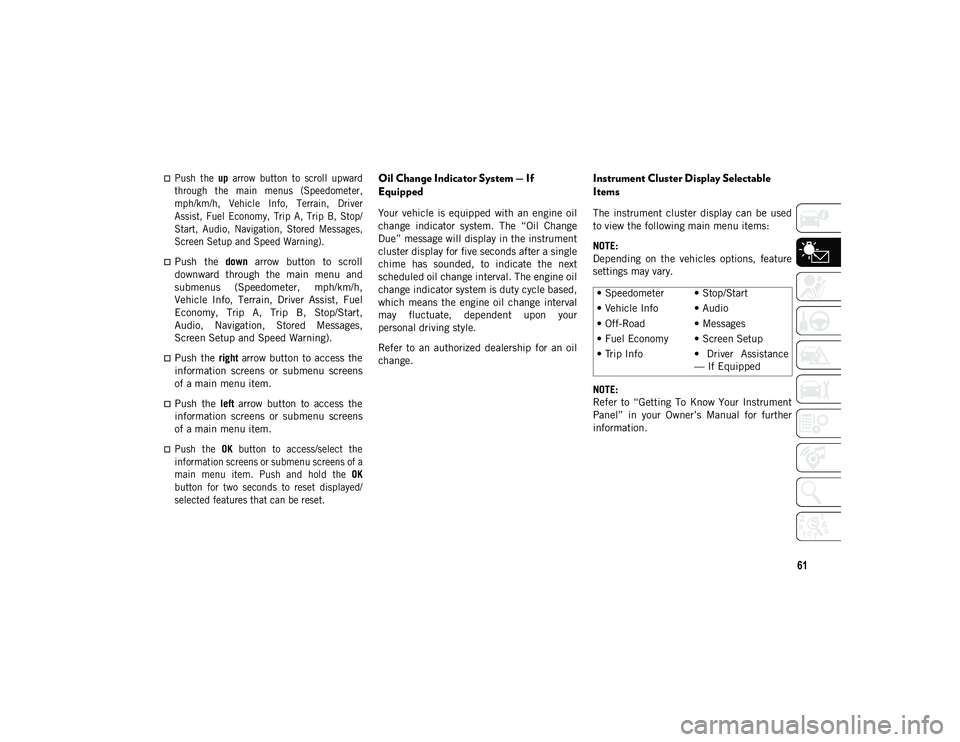
61
Push the up arrow button to scroll upward
through the main menus (Speedometer,
mph/km/h, Vehicle Info, Terrain, Driver
Assist, Fuel Economy, Trip A, Trip B, Stop/
Start, Audio, Navigation, Stored Messages,
Screen Setup and Speed Warning).
Push the down arrow button to scroll
downward through the main menu and
submenus (Speedometer, mph/km/h,
Vehicle Info, Terrain, Driver Assist, Fuel
Economy, Trip A, Trip B, Stop/Start,
Audio, Navigation, Stored Messages,
Screen Setup and Speed Warning).
Push the right arrow button to access the
information screens or submenu screens
of a main menu item.
Push the left arrow button to access the
information screens or submenu screens
of a main menu item.
Push the OK button to access/select the
information screens or submenu screens of a
main menu item. Push and hold the OK
button for two seconds to reset displayed/
selected features that can be reset.
Oil Change Indicator System — If
Equipped
Your vehicle is equipped with an engine oil
change indicator system. The “Oil Change
Due” message will display in the instrument
cluster display for five seconds after a single
chime has sounded, to indicate the next
scheduled oil change interval. The engine oil
change indicator system is duty cycle based,
which means the engine oil change interval
may fluctuate, dependent upon your
personal driving style.
Refer to an authorized dealership for an oil
change.
Instrument Cluster Display Selectable
Items
The instrument cluster display can be used
to view the following main menu items:
NOTE:
Depending on the vehicles options, feature
settings may vary.
NOTE:
Refer to “Getting To Know Your Instrument
Panel” in your Owner’s Manual for further
information. • Speedometer • Stop/Start
• Vehicle Info • Audio
• Off-Road • Messages
• Fuel Economy • Screen Setup
• Trip Info • Driver Assistance
— If Equipped
2020_JEEP_JL_WRANGLER_UG_RHD_UK.book Page 61
Page 64 of 330
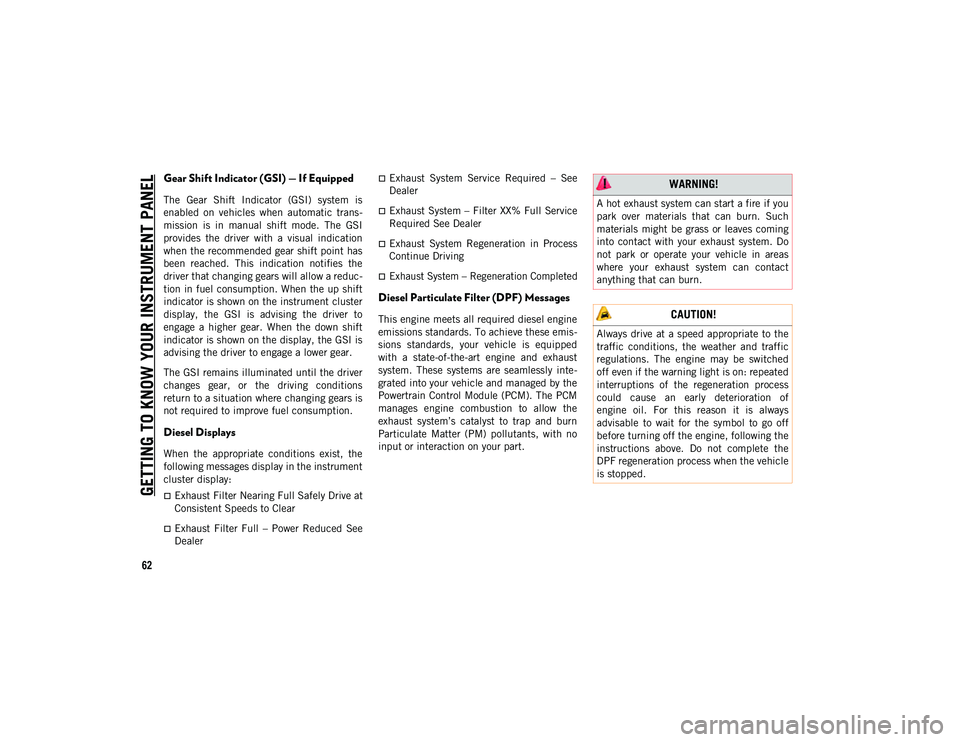
GETTING TO KNOW YOUR INSTRUMENT PANEL
62
Gear Shift Indicator (GSI) — If Equipped
The Gear Shift Indicator (GSI) system is
enabled on vehicles when automatic trans-
mission is in manual shift mode. The GSI
provides the driver with a visual indication
when the recommended gear shift point has
been reached. This indication notifies the
driver that changing gears will allow a reduc -
tion in fuel consumption. When the up shift
indicator is shown on the instrument cluster
display, the GSI is advising the driver to
engage a higher gear. When the down shift
indicator is shown on the display, the GSI is
advising the driver to engage a lower gear.
The GSI remains illuminated until the driver
changes gear, or the driving conditions
return to a situation where changing gears is
not required to improve fuel consumption.
Diesel Displays
When the appropriate conditions exist, the
following messages display in the instrument
cluster display:
Exhaust Filter Nearing Full Safely Drive at
Consistent Speeds to Clear
Exhaust Filter Full – Power Reduced See
Dealer
Exhaust System Service Required – See
Dealer
Exhaust System – Filter XX% Full Service
Required See Dealer
Exhaust System Regeneration in Process
Continue Driving
Exhaust System – Regeneration Completed
Diesel Particulate Filter (DPF) Messages
This engine meets all required diesel engine
emissions standards. To achieve these emis -
sions standards, your vehicle is equipped
with a state-of-the-art engine and exhaust
system. These systems are seamlessly inte -
grated into your vehicle and managed by the
Powertrain Control Module (PCM). The PCM
manages engine combustion to allow the
exhaust system’s catalyst to trap and burn
Particulate Matter (PM) pollutants, with no
input or interaction on your part.
WARNING!
A hot exhaust system can start a fire if you
park over materials that can burn. Such
materials might be grass or leaves coming
into contact with your exhaust system. Do
not park or operate your vehicle in areas
where your exhaust system can contact
anything that can burn.
CAUTION!
Always drive at a speed appropriate to the
traffic conditions, the weather and traffic
regulations. The engine may be switched
off even if the warning light is on: repeated
interruptions of the regeneration process
could cause an early deterioration of
engine oil. For this reason it is always
advisable to wait for the symbol to go off
before turning off the engine, following the
instructions above. Do not complete the
DPF regeneration process when the vehicle
is stopped.
2020_JEEP_JL_WRANGLER_UG_RHD_UK.book Page 62
Page 65 of 330
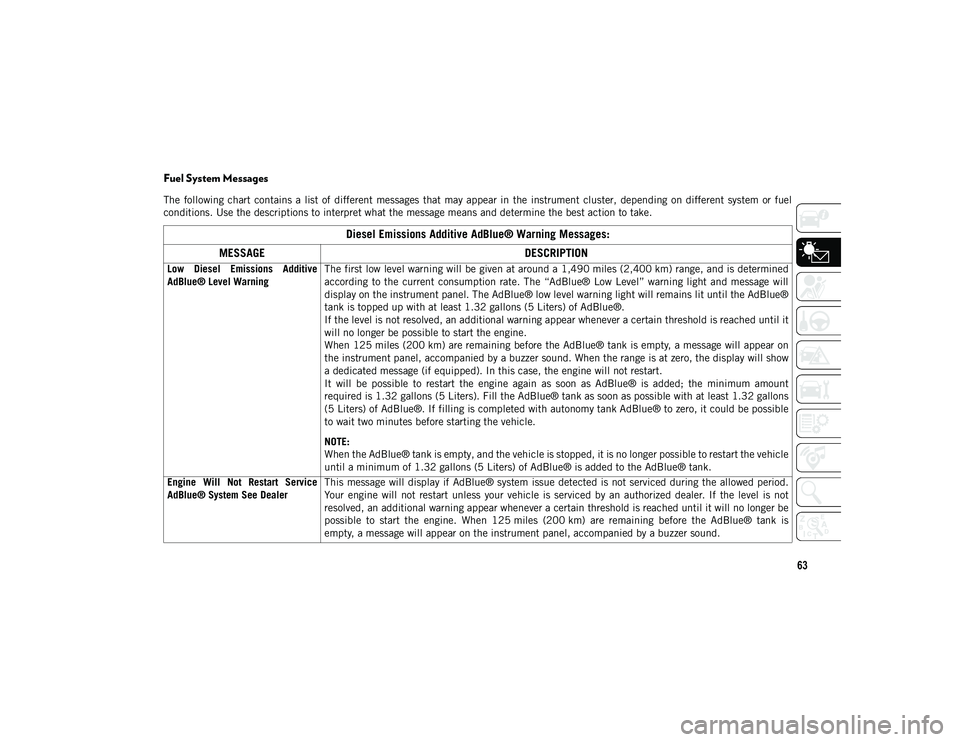
63
Fuel System Messages
The following chart contains a list of different messages that may appear in the instrument cluster, depending on different system or fuel
conditions. Use the descriptions to interpret what the message means and determine the best action to take.
Diesel Emissions Additive AdBlue® Warning Messages:
MESSAGE DESCRIPTION
Low Diesel Emissions Additive
AdBlue® Level WarningThe first low level warning will be given at around a 1,490 miles (2,400 km) range, and is determined
according to the current consumption rate. The “AdBlue® Low Level” warning light and message will
display on the instrument panel. The AdBlue® low level warning light will remains lit until the AdBlue®
tank is topped up with at least 1.32 gallons (5 Liters) of AdBlue®.
If the level is not resolved, an additional warning appear whenever a certain threshold is reached until it
will no longer be possible to start the engine.
When 125 miles (200 km) are remaining before the AdBlue® tank is empty, a message will appear on
the instrument panel, accompanied by a buzzer sound. When the range is at zero, the display will show
a dedicated message (if equipped). In this case, the engine will not restart.
It will be possible to restart the engine again as soon as AdBlue® is added; the minimum amount
required is 1.32 gallons (5 Liters). Fill the AdBlue® tank as soon as possible with at least 1.32 gallons
(5 Liters) of AdBlue®. If filling is completed with autonomy tank AdBlue® to zero, it could be possible
to wait two minutes before starting the vehicle.
NOTE:
When the AdBlue® tank is empty, and the vehicle is stopped, it is no longer possible to restart the vehicle
until a minimum of 1.32 gallons (5 Liters) of AdBlue® is added to the AdBlue® tank.
Engine Will Not Restart Service
AdBlue® System See Dealer This message will display if AdBlue® system issue detected is not serviced during the allowed period.
Your engine will not restart unless your vehicle is serviced by an authorized dealer. If the level is not
resolved, an additional warning appear whenever a certain threshold is reached until it will no longer be
possible to start the engine. When 125 miles (200 km) are remaining before the AdBlue® tank is
empty, a message will appear on the instrument panel, accompanied by a buzzer sound.
2020_JEEP_JL_WRANGLER_UG_RHD_UK.book Page 63
Page 71 of 330

69
The “ESC OFF Indicator Light” and the
“ESC Indicator Light” come on momen-
tarily each time the ignition is placed in
the ON/RUN or ACC/ON/RUN position.
The ESC system will make buzzing or
clicking sounds when it is active. This is
normal; the sounds will stop when ESC
becomes inactive.
This light will come on when the vehicle is
in an ESC event.
— Electronic Stability Control (ESC) OFF
Warning Light — If Equipped
This warning light indicates the Electronic
Stability Control (ESC) is off.
Each time the ignition is turned to ON/RUN
or ACC/ON/RUN, the ESC system will be on,
even if it was turned off previously.
— Loose Fuel Filler Cap Warning Light —
If Equipped
This warning light will illuminate when the
fuel filler cap is loose. Properly close the
filler cap to disengage the light. If the light
does not turn off, please see an authorized
dealer.
— Low Fuel Warning Light
When the fuel level reaches approximately
2.0 gal (7.5 L), this light will turn on and a
chime will sound. The light will remain on
until fuel is added.
— Low Washer Fluid Warning Light — If
Equipped
This warning light will illuminate when the
windshield washer fluid is low.
— Engine Check/Malfunction Indicator
Warning Light (MIL)
The Engine Check/Malfunction Indicator
Light (MIL) is a part of an Onboard Diag -
nostic System called OBD II that monitors
engine and automatic transmission control
systems. This warning light will illuminate
when the ignition is in the ON/RUN position
before engine start. If the bulb does not
come on when turning the ignition switch
from OFF to ON/RUN, have the condition
checked promptly. Certain conditions, such as a loose or
missing gas cap, poor quality fuel, etc., may
illuminate the light after engine start. The
vehicle should be serviced if the light stays
on through several typical driving styles. In
most situations, the vehicle will drive
normally and will not require towing.
When the engine is running, the MIL may
flash to alert serious conditions that could
lead to immediate loss of power or severe
catalytic converter damage. The vehicle
should be serviced by an authorized dealer
as soon as possible if this occurs. WARNING!
A malfunctioning catalytic converter, as
referenced above, can reach higher
temperatures than in normal operating
conditions. This can cause a fire if you
drive slowly or park over flammable
substances such as dry plants, wood,
cardboard, etc. This could result in death
or serious injury to the driver, occupants or
others.
2020_JEEP_JL_WRANGLER_UG_RHD_UK.book Page 69